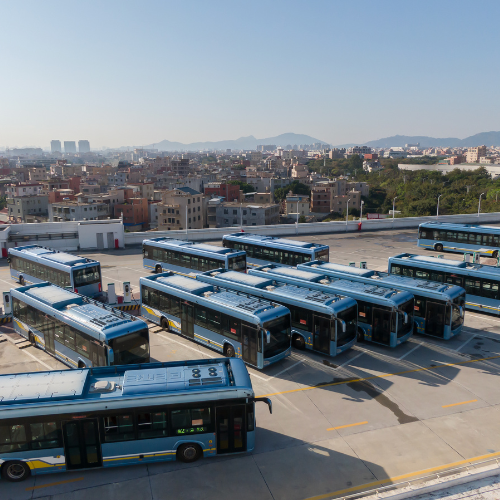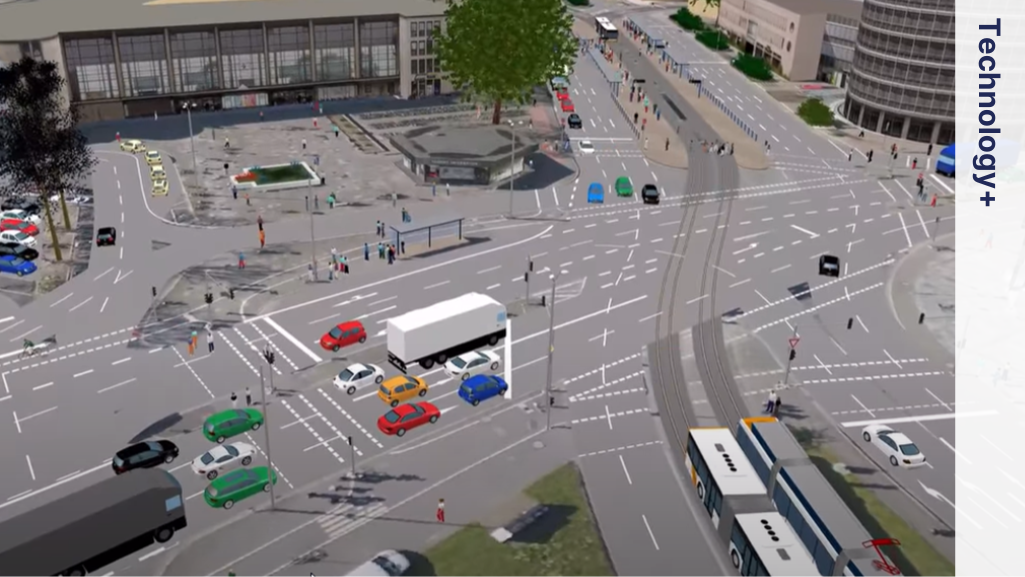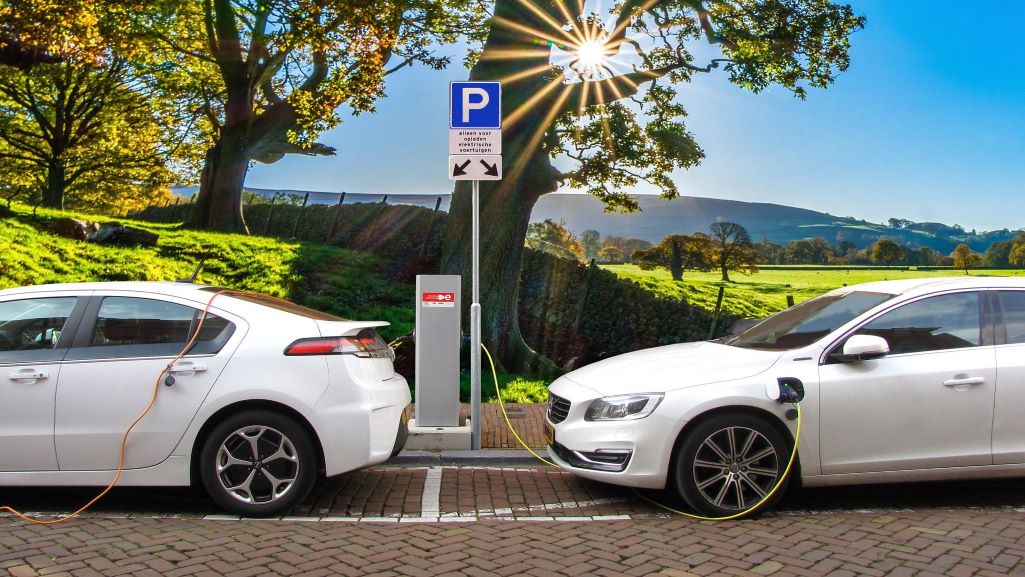Replacing diesel buses with electric buses is important, but also complex. It requires large investments and careful planning. However, the use of traffic models for e-bus planning can significantly reduce the risks for bus operators.
Driven by the need to improve air quality and reduce noise pollution, the number of electric buses is growing. Legislation requires bus operators who have not yet converted to act now, or at least start planning for the change.
What to consider when converting to electric buses
Battery-powered buses are locally non-polluting and quieter. However, electric buses have two major drawbacks: their range is limited compared to diesel-powered buses; and recharging takes longer compared to refueling.
Therefore, operators need to consider the charging power and charging capacity of e-buses for a given timetable.
Operators should also consider the infrastructure required and the capacity of the local electrical grid.
Then there is the cost of the batteries. Batteries are expensive and typically represent more than 50% of the total investment in e-buses.
Another consideration is how to avoid battery fade, which occurs when a battery doesn’t reach the capacity of a new one. Slower charging prevents battery fade, and high-capacity batteries allow faster charging.
Another factor is the depth of discharge. As with cell phones, an e-bus battery will die faster if it is fully discharged and then fully recharged.
Temperature management is also critical to extending the life of an e-bus battery.

The ideal electric bus battery
There is no “one size fits all” e-bus battery. During electric bus planning, the choice of battery depends on your network, schedule and charging strategy.
Here are some factors to consider for the right battery for your fleet:
- Maximum efficiency: To get the most miles per kilowatt-hour, the battery should be as light as possible. High-capacity batteries are much heavier.
- Lower cost: The smaller the battery, the lower the capital investment.
- Long range: High-capacity batteries require fewer charging stations, making it cheaper to build the grid infrastructure.
- Robust: High-capacity batteries are more resistant to battery degradation. –
- Maximum charging power: To save time during charging.
Watch a comparison of high- and low-capacity e-bus batteries in this webinar, between 06:50-08:55

Electric bus charging strategies
There are three common charging strategies for fleets of electric buses:
- Overnight charging: Charging is done at a central depot. The chargers are relatively slow because one has the whole night to charge. Usually, high-capacity batteries are used, with over 200 kilowatt hours. The bus ranges are about 250 kilometers.
- Opportunity charging: Charging facilities are decentralized and are located at bus stops. The buses can charge within a few minutes, for example during a layover. Here, fast chargers of 150-500kW must be used. Smaller batteries are required, as the ranges are smaller – the buses only need to reach the next charging point.
- In-Motion charging: Here, trolley buses are charged while driving below catenary. In route sections without catenaries, the buses simply use their battery, so they can afford smaller battery sizes and slower charging.

Converting bus fleets to electric
Converting bus fleets from diesel to electric is much more than buying new vehicles and charging them at the depot. It often means rethinking the entire system.
Modeling and simulation software, such as PTV Visum, can help smooth this transition. Software can answer the pressing questions before the transition:
- What system to use – battery, hybrid, or trolley?
- Which vehicles, in terms of range, capacity, and charging times?
- How many of these vehicles?
- How many charging stations to build and where to locate them?
- What type of charging infrastructure?
- Is there a need for network design – line lengths, transfer points, or hybrid operations?

Planning electric bus operations with simulations
Traffic modeling with PTV Visum is the way to answer the above questions.
To get the user’s perspective: Create a traffic assignment by combining supply (given by a timetable) and demand (given by ridership and demand modeling). This gives us the user’s perspective: By calculating travel and waiting times, we can predict mode splits and shifts.
To get the operator’s perspective: Use line blocking, also known as “vehicle scheduling”. Electric bus planning with line blocking, enables us to calculate how many vehicles the operator needs and how many empty miles they will run. As a result, you get a clear picture of bus operating costs, energy consumption, and fleet emissions.

Line blocking
Now let’s see how to create a line block, and then how to extend this procedure to electric bus planning and the new fleet’s operations.
The main concept of line blocking is to convert vehicle trips from a timetable into vehicle trips called “blocks”. The optimal block minimizes operating costs. Therefore, by applying costs to route blocks, it is possible to calculate which variant is more cost efficient. This approach also applies to battery electric vehicles.
Watch how to create a line blocking in PTV Visum: Show video from 16:25-19:05
This step-by-step example of strategic e-bus planning procedure is available here, or within PTV Visum under: Help > Examples > Open Example Directory.

Setting up line blocking in PTV Visum
To set up line blocking for e-bus systems in PTV Visum, proceed as follows:
First, introduce a frequently repeated activity – charging. To define the frequency, define the charging time and the consumption function. The functions are linear, i.e. if you set the full charge time to two hours, one hour will charge half the battery. The discharge or consumption function is also straightforward: If the range of the e-bus is 150 km, every km you drive will reduce your charge.
Next, introduce a new vehicle combination called “e-bus”. Define the range and cost of all activities, including the cost of recharging.
Then set up your timetable and the routes the new e-buses will run.
Set up the depot where the new e-buses will be recharged.
The result is a new block version – a calculated scenario. You can use it to compare different settings and results.
Watch how this is done in the video, between 19:09-23:08.

Analyzing results of electric bus line blocking
After setting up a line-blocking procedure for electric bus operations, it’s time to explore its results. Analyzing the results in PTV Visum allows you to know the real cost of e-bus ownership, and to decide which scenario best fits your network and supply.
Example 1 – Overnight charging: Watch this video from 23:09 to 24:57. In this example, the results indicate that the e-bus battery capacity is insufficient.
Example 2 – Opportunity charging: Watch the video from 24:58 to 26:26. In this example, the results indicate that you should increase the charging power at the charging locations to maintain capacity.
Example 3 – In-motion charging: Watch the video from 26:28-27:31. The key takeaway here is that there are too few catenaries and too little charging power, or the batteries are too small.
Example 4 – Overnight charging: Watch the video from 27:32-28:31. This is an example with an advanced consumption model, where the results alert us to insufficient battery capacity.
In addition, users of PTV Visum can easily import elevation data, which might be of use to calculate the energy consumption of the vehicle and therefore its range.

Conclusion
Legislation is forcing transit operators to consider adding zero-emission electric bus vehicles to their fleets. But electric bus planning is much more than just changing the energy source of the fleet: it means designing a new system – and it should be well planned.
However, this transition can be accomplished without spending a lot of time or collecting a lot of new data. Simulations, such as those provided by PTV Visum software, allow you to analyze different scenarios. As a result, you have a reliable basis for your calculations and know the total cost of ownership.




